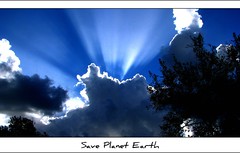
- Image by ozgurmulazimoglu via Flickr
The Earth has entered a new geological period in which human influence dominates the state of the planet, compounding uncertainty about the future.
In 2000, as the green shoots of spring cracked through winter’s icy grip on the northern hemisphere, a letter from the Nobel laureate Paul Crutzen and his colleague Eugene Stoermer appeared in the news bulletin of the International Geosphere-Biosphere Programme. In it, Crutzen and Stoermer made the case that the Holocene, the geological epoch that had held sway on Earth for the past 12,000 years, was at an end. In its place, with a start date pegged to the late 18th century commercialization of James Watt’s steam engine, was the Anthropocene, an epoch defined by the influence of humanity’s collective actions. Crutzen was an apt messenger—his Nobel came from work clarifying how the activities of a small number of people had inadvertently initiated a chain reaction that grievously damaged the globe’s protective layer of atmospheric ozone.
The proposal was more widely accepted than a very similar, earlier idea from the journalist Andrew Revkin (he wrote about the “Anthrocene” in 1992), but at the time it still generated considerable controversy. This spring, ten years on, the Anthropocene’s reality is harder to challenge, particularly as manifested through climate change. A surfeit of carbon dioxide is pushing up the planet’s thermostat and initiating a cascade of clear, measurable effects, least of all plants and animals that are waking ever-earlier from winter dormancy. As reported in an upcoming issue of Biology Letters, the latest addition to this list of “early risers” is the Common Brown Butterfly of Australia, which is emerging some 10 days earlier than it did 65 years ago. Nature is adjusting to the Anthropocene. Alas, the same can’t yet be said for world leaders, particularly a small but vocal number of cynical US politicians and corporations.
For humans, adjustments to a warming world can be divided into three categories: mitigation, adaptation, and remediation. The first encompasses things like cutting greenhouse-gas emissions and boosting energy efficiency, and is by far the favorite of modern policy discussions. The second involves actions like building higher seawalls against potential rising oceans, or shifting agricultural practices to align with changing rainfall and temperature. The third option is better known as “geoengineering,” and entails deliberate interventions designed to decrease rising temperatures. Some proposals suggest using atmospheric aerosols or giant orbital mirrors to block sunlight; others plan to capture and sequester carbon by injecting it into the ground or dumping it in the ocean. Though in terms of dollars and cents many geoengineering methods are cheap enough for solitary nations or even private individuals to undertake, few have been thoroughly tested. Fear and uncertainty are the reasons: Geoengineering doesn’t so much adjust to the Anthropocene as kick it into overdrive. All its variations carry major risks and uncertainties.
Related articles by Zemanta
- 6 Ways We’re Already Geoengineering Earth (wired.com)
- Q&A: Geoengineering Is ‘A Bad Idea Whose Time Has Come’ (wired.com)
- Should Earth Scientists Take a “Hippocratic Oath”? (wired.com)
- Geoengineering: Plan B, Triage Method or Dangerous Illusion? (worldchanging.com)







![Reblog this post [with Zemanta]](http://img.zemanta.com/reblog_b.png?x-id=0168480a-cc51-4b30-8e09-59ee9aa943af)
